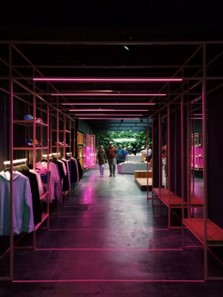
The onset of the COVID19 pandemic has heralded a reinvention of the shopping malls. With the lockdown enforced midway through 2020, malls were a shadow of their former self. It became a deserted space which was previously filled with a bustling crowd.
As the pandemic calmed down, significant changes to the sector are expected. The challenge for owners and developers of these shopping malls will be identifying ways to keep their space relevant and aligned to the current demand trends.
Here are 3 possible changes seen in shopping malls.
1. Omni Channel Marketing

Since the rise of e-commerce, physical shopping shops have faced stiff competition. The pandemic has only served to aggravate the problem, with restrictions forcing customers to go online for their shopping. Hence, this has resulted in a decline in sales revenue for physical shopping outlets.
As the famous saying goes, “If you can’t beat them, join them”.
Many brands have turned toward e-commerce to boost their sales. However, they have not abandoned their physical shopping spaces just yet, and have adopted this dual approach (omni-channel) for operations.
Certain developers have gone one step further to help their tenants, by creating online shopping platforms. Take for instance CapitaLand’s launch of eCapitaMall. This allows customers to conveniently shop online in any of the shopping tenants under CapitaLand, ensuring a good user experience whilst boosting sales revenue.
Overall, it’s likely that shopping malls will continue leasing out their spaces to shopping brands, but these tenants might cut down on the rented spaces with online platforms providing an alternative source of revenue.
2. Experiential Shopping Malls

With the modern-day shopper accustomed to purchasing whatever he needs from the comforts of home, it is increasingly tough to get them to travel to Shopping malls. Thus, it is important to tap into the experiential aspect of shopping.
Although e-commerce is very convenient and useful, it cannot completely replace the actual experience of fitting and trying out clothes. This aspect is likely to keep shoppers coming to physical shopping outlets.
Shopping malls or their tenants can take this experiential aspect a level higher, by incorporating virtual or augmented reality. This will allow shoppers to have a new and different experience, while also giving them a better idea of how’d they’d look with the product.
The shopping mall can also improve the shopping experience by bringing in “hands free shopping”, to ensure that the shopper isn’t bagged down by his shopping items.
When the shopper first enters the Mall, he is given a booklet to list down the items purchased. The department will then give him a receipt for every item purchased and payment is only made at the end of his shopping trip. Shopping bags are then delivered to his car, ensuring that he doesn’t have to carry any of them throughout his trip.
I don’t know about you, but it sounds like a pretty decent shopping trip to me.
3. Trendy Tenant Mix
Mixed-use malls are known to do better than standalone malls, and that’s due to the vast array of activities and products on offer. Although there has been a gradual shift towards Mixed-use malls, the tenant mix has taken on greater importance with the changing demand trends.
For instance, the newly redeveloped Funan Mall has an interesting tenant mix, with a cinema, theatre, roof futsal court, cycling lanes inside the mall and incubator pods for designers. This is due to the increasing interest in the arts, as well as the growing emphasis on a healthy lifestyle.
Funan Mall’s fortunes are a stark contrast from its neighbouring mall in Peninsula Shopping Centre. The latter attracts few shoppers having limited itself to a couple of tenant types such as music stores and sports shops.
Thus, shopping malls will have to be increasingly meticulous when choosing their tenants, with focus on those that are in trend so as to keep up with the times and keep visitors coming back.
Conclusion: Shopping Malls
The shopping mall faces a huge struggle to adapt and keep itself relevant in the face of changing demand trends and the rise of e-commerce. However, there are many ways of fending off competition and playing to its strengths, such as the shopper’s experience.
Although many brands, developers and mall owners are still in the midst of finding the best solution, the current approaches in the form of omni channel marketing, improving shopping experience and careful selection of trendy tenants are great ways to keep the shopping mall in business.
Only time will tell how well the shopping malls respond to this challenge, but the advent of technology might just ameliorate the situation and help shopping malls to reinvent themselves. Watch this space, e-commerce might just be a thing of the past in the blink of an eye.
Want to find the best mortgage rate in town? Check out our free comparison service to learn more!
Read more of our posts below!

